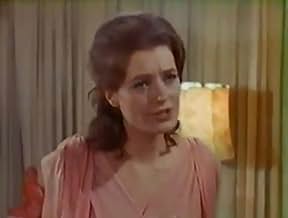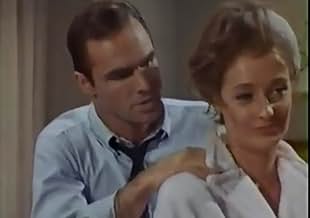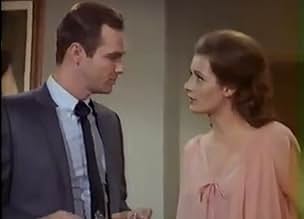Ajouter une intrigue dans votre langueThe crime busting techniques of Iroquois detective John Hawk of the New York City District Attorney's office.The crime busting techniques of Iroquois detective John Hawk of the New York City District Attorney's office.The crime busting techniques of Iroquois detective John Hawk of the New York City District Attorney's office.
Parcourir les épisodes
Avis en vedette
Before playing a monotone detective in the 1969 series DAN AUGUST, young mustache-less/Marlon-Brando-looking Burt Reynolds played a monotone detective named HAWK... the difference being he's, like the initial breakthrough role on GUNSMOKE, part Indian... and instead of investigating old friends mostly during daylight, the twist here's a seedy gumshoe style world after midnight...
In this case, one of the few episodes available, THE HANDS OF CORBIN CLAYBROOKE, centering on an offbeat artist with gorgeous assistant Marianna Hill teamed with a handsome criminal that had murdered another artist, both involved in a scam a bit difficult to follow, for the audience more than Burt's titular detective, knowing the girl's involved as if he'd seen enough noir films...
Providing young Burt his first of two one-season-shows before the second of three catapults: first on the big screen for DELIVERANCE before riding high in SMOKEY AND THE BANDIT...
Meanwhile, it's already famously infamous that his comedic brand derailed an otherwise serious dramatic career... yet he could have used some of that likeable levity both in DAN AUGUST and HAWK since, liken to Jack Nicholson, when Burt discovered a more breezy style, even his dramatic performances improved.
In this case, one of the few episodes available, THE HANDS OF CORBIN CLAYBROOKE, centering on an offbeat artist with gorgeous assistant Marianna Hill teamed with a handsome criminal that had murdered another artist, both involved in a scam a bit difficult to follow, for the audience more than Burt's titular detective, knowing the girl's involved as if he'd seen enough noir films...
Providing young Burt his first of two one-season-shows before the second of three catapults: first on the big screen for DELIVERANCE before riding high in SMOKEY AND THE BANDIT...
Meanwhile, it's already famously infamous that his comedic brand derailed an otherwise serious dramatic career... yet he could have used some of that likeable levity both in DAN AUGUST and HAWK since, liken to Jack Nicholson, when Burt discovered a more breezy style, even his dramatic performances improved.
It's not often that a television series attempts to push the envelope on a social issue, but this program was one that tried to do it, even as it presented itself as a standard cop show.
Lieutenant John Hawk, as played by Burt Reynolds, was an NYPD detective working with the DA's office on various cases. But Hawk wasn't just a detective, he was a full blooded Iroquois tribesman. Elements of the show had Hawk battling not just the "bad guys," but also fellow officers whose racism and prejudice had them challenging and attempting to diminish his accomplishments.
Notably Mr. Reynolds did have some Native American blood on his father's side of the family. He was part Cherokee and was playing an Indian on the CBS western, "Gunsmoke" before he got this role, his first lead in any TV or film production.
Hawk had a partner, Detective Dan Carter, played by Wayne Grice. Just in case the issues of racism weren't obvious enough for you, Hawk's partner was a Black American, which may have been an attempt to capitalize on another popular series of the day, "I Spy." Carter was what we would call today, a nerd: a by the book, stay out of trouble, high intelligence level cop just out to do the job. He was the opposite of Hawk, low-key, avoid the confrontation and keep the peace kind of fellow.
The way they handled the story of Hawk's history was an interesting choice. There were some episodes of the series where it didn't come into play at all, while others where it was a major part of the storyline. It's clear that they were really trying to have the issue of Hawk's heritage be a part of the plot in organic ways, rather than it being a requisite element of every week's episode.
Also important was that Burt Reynolds did just about all of his own stunts in the show. If a fight scene needed to be a part of that week's episode, it was Burt throwing the punches, which added a level of gritty realism to the process. And, of course, there were a lot of fight scenes to be done.
New York played a part in that Hawk was typically a "Second Shifter," so he was working nights and overnights. The bright lights of the Big City came into play, as Hawk drove around town in his blue 1966 Pontiac Bonneville with the siren light on the dashboard. So stylish!
Burt even got to direct an episode or two of the series as it ran, which gave him more opportunities to slug the bad guys and show off the sights and sounds of New York, as the series was filmed on location.
Thanks to Reynolds' eventual success in acting, this show has has managed to remain on the pop culture scene, though the elements of his ancestry might bring the question of cultural appropriation, nowadays. After all, his Native roots were barely acknowledged in any of his roles that followed.
The fatal problem for the program was the schedule. "Hawk" ran opposite the hugely popular "The Dean Martin Show" on NBC, and even a straight-shooting cop like Hawk couldn't outrun a Rat Packer.
Lieutenant John Hawk, as played by Burt Reynolds, was an NYPD detective working with the DA's office on various cases. But Hawk wasn't just a detective, he was a full blooded Iroquois tribesman. Elements of the show had Hawk battling not just the "bad guys," but also fellow officers whose racism and prejudice had them challenging and attempting to diminish his accomplishments.
Notably Mr. Reynolds did have some Native American blood on his father's side of the family. He was part Cherokee and was playing an Indian on the CBS western, "Gunsmoke" before he got this role, his first lead in any TV or film production.
Hawk had a partner, Detective Dan Carter, played by Wayne Grice. Just in case the issues of racism weren't obvious enough for you, Hawk's partner was a Black American, which may have been an attempt to capitalize on another popular series of the day, "I Spy." Carter was what we would call today, a nerd: a by the book, stay out of trouble, high intelligence level cop just out to do the job. He was the opposite of Hawk, low-key, avoid the confrontation and keep the peace kind of fellow.
The way they handled the story of Hawk's history was an interesting choice. There were some episodes of the series where it didn't come into play at all, while others where it was a major part of the storyline. It's clear that they were really trying to have the issue of Hawk's heritage be a part of the plot in organic ways, rather than it being a requisite element of every week's episode.
Also important was that Burt Reynolds did just about all of his own stunts in the show. If a fight scene needed to be a part of that week's episode, it was Burt throwing the punches, which added a level of gritty realism to the process. And, of course, there were a lot of fight scenes to be done.
New York played a part in that Hawk was typically a "Second Shifter," so he was working nights and overnights. The bright lights of the Big City came into play, as Hawk drove around town in his blue 1966 Pontiac Bonneville with the siren light on the dashboard. So stylish!
Burt even got to direct an episode or two of the series as it ran, which gave him more opportunities to slug the bad guys and show off the sights and sounds of New York, as the series was filmed on location.
Thanks to Reynolds' eventual success in acting, this show has has managed to remain on the pop culture scene, though the elements of his ancestry might bring the question of cultural appropriation, nowadays. After all, his Native roots were barely acknowledged in any of his roles that followed.
The fatal problem for the program was the schedule. "Hawk" ran opposite the hugely popular "The Dean Martin Show" on NBC, and even a straight-shooting cop like Hawk couldn't outrun a Rat Packer.
Between this and Quinn Martin's Dan August, Burt's potential as a dramatic action star seemed sealed. He was good in this moody, jazzy and sometimes violent series. There was always that emphasis on his (American) Indian heritage and the wretchedness of his job (one episode dealt with the unrewarding job of a stool pigeon). Too bad Burt didn't seem to care much about his movie career considering the spate of bad films he made in the 70's (Deliverance notwithstanding).
"Hawk" (1966) had a brilliant core idea of filming a detective series on location in New York City at night. Making the central character an American Indian and casting 30-year old Burt Reynolds as Lt. John Hawk were also extremely smart moves. (David Carradine was also considered for the role of Hawk.) This show had enormous promise.
"Hawk" was created by Emmy winner Allan Sloane ("Teacher, Teacher", "East Side, West Side", "The Breaking Point"). Sloane also wrote several strong episodes. The executive producer was Hubbell Robinson ("Boris Karloff's Thriller", "87th Precint"), who always strove for quality.
The stories were literate and intriguing (coming from the same people who were doing "The Defenders" and the other top dramatic shows of the day.) The casting of guests was impeccable, often drawing from the fine pool of actors working out of New York City. Some of the guest stars were Gene Hackman, Robert Duvall, Martin Sheen, Frank Converse, Philip Bosco, Scott Glenn, Diana Muldaur, Diane Baker, Louise Sorel, Bradford Dillman, Carol Rossen, James Best, Emily Prager and Beverlee McKinsey.
The main problem with the series was that the character of John Hawk was an arrogant jerk, apparently modeled after Ben Casey with a little Marlon Brando thrown in. Hawk had a big chip on his shoulder. It was impossible to like him. Burt Reynolds was never more appealing than as "half-breed" blacksmith Quint Asper on "Gunsmoke" for two years in the early 60's. The writers and producers should have let Reynolds play Hawk more like Quint Asper.
Another weakness was that Hawk always had to be right and always had to perform the heroics solo. This made Hawk even more insufferable. The producers should have given Hawk a partner who was an equal rather than an eager beaver trainee. Gerald S. O'Loughlin, Ossie Davis or Frank Converse could have been good choices for Hawk's partner. Reynolds could have easily developed a humorous, easy rapport with any of those actors. The partner could have shared some of the heroics and might even have made fun of John Hawk's preening self-importance.
Even with its weaknesses, "Hawk" was an excellent effort, and I wish it had lasted longer. With just a little tweaking of the main character, this could have been one of the finest TV cop shows in history. Indeed, th premise of "Hawk" was so good, it could be remade as a series today.
"Hawk" was created by Emmy winner Allan Sloane ("Teacher, Teacher", "East Side, West Side", "The Breaking Point"). Sloane also wrote several strong episodes. The executive producer was Hubbell Robinson ("Boris Karloff's Thriller", "87th Precint"), who always strove for quality.
The stories were literate and intriguing (coming from the same people who were doing "The Defenders" and the other top dramatic shows of the day.) The casting of guests was impeccable, often drawing from the fine pool of actors working out of New York City. Some of the guest stars were Gene Hackman, Robert Duvall, Martin Sheen, Frank Converse, Philip Bosco, Scott Glenn, Diana Muldaur, Diane Baker, Louise Sorel, Bradford Dillman, Carol Rossen, James Best, Emily Prager and Beverlee McKinsey.
The main problem with the series was that the character of John Hawk was an arrogant jerk, apparently modeled after Ben Casey with a little Marlon Brando thrown in. Hawk had a big chip on his shoulder. It was impossible to like him. Burt Reynolds was never more appealing than as "half-breed" blacksmith Quint Asper on "Gunsmoke" for two years in the early 60's. The writers and producers should have let Reynolds play Hawk more like Quint Asper.
Another weakness was that Hawk always had to be right and always had to perform the heroics solo. This made Hawk even more insufferable. The producers should have given Hawk a partner who was an equal rather than an eager beaver trainee. Gerald S. O'Loughlin, Ossie Davis or Frank Converse could have been good choices for Hawk's partner. Reynolds could have easily developed a humorous, easy rapport with any of those actors. The partner could have shared some of the heroics and might even have made fun of John Hawk's preening self-importance.
Even with its weaknesses, "Hawk" was an excellent effort, and I wish it had lasted longer. With just a little tweaking of the main character, this could have been one of the finest TV cop shows in history. Indeed, th premise of "Hawk" was so good, it could be remade as a series today.
Hawk retains the grittiness of an earlier Screen Gems series, Naked City, but has a nice touch with it's use of color film in mostly night shots. One of the best aspects is the sound by Don Kirshner, and the very eerie nocturnal theme music by Kenyon Hopkins played while Hawk drives his 1966 Pontiac Bonneville up 7th Avenue at 11:52:59 pm (according to a digital clock).
Le saviez-vous
- AnecdotesBurt Reynolds' salary for the show was six thousand dollars a week.
- ConnexionsFeatured in 7 Nights to Remember (1966)
Meilleurs choix
Connectez-vous pour évaluer et surveiller les recommandations personnalisées
- How many seasons does Hawk have?Propulsé par Alexa
Détails
- Date de sortie
- Pays d’origine
- Langue
- Aussi connu sous le nom de
- Porucznik Hawk w akcji
- Lieux de tournage
- société de production
- Consultez plus de crédits d'entreprise sur IMDbPro
- Durée1 heure
- Mixage
- Rapport de forme
- 1.33 : 1
Contribuer à cette page
Suggérer une modification ou ajouter du contenu manquant





















